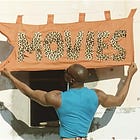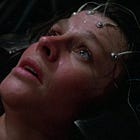Imaginary Software of the Filmmaking Future
How to use, confuse, or avoid your new robot crewmate.
Written by Graeme Cole for Unfound Peoples Videotechnic.
A soft imaginary science for conceptualising the film arts in (and beyond) this moment of radical retooling. The potential of misusing AI and other filmmaking software to fully express your withered soul.
Evergreen, esoteric knowledge, originally published in the spring of 2024.
46 micro-essays, including:
🧶 How to untangle the knitting patterns of your mind and zap them up onto the cinema screen.
🤘 Friction, danger, and accidents - or, What Gets You Out of Real, Physical Bed In the Morning. And Onto An Actual Film Set.
🤖 Naive robots and the deep programming of daft assumptions.
🎛️ Appendages, interfaces, and cheats.
Index
Read in any order.
Underlined links lead to anchorpoints - each one a micro-essay or exercise - within the containing lesson.
Ugarte’s ending | Many years ago, Luis Buñuel told a story from his life that we might apply to how we think about algorithmic filmmaking today.
Decide | The decisions the filmmaker faces after breakfast and after civilisation.
The art of the past | Filmmaking’s stubborn relationship with the past - and how it must be negotiated before conquering the future.
Advance/guard | The unbearable fizziness of being avant-garde.
Probable filmmaking | The forking paths from possible filmmaking to probable filmmaking.
Dots and threads | How your generative software practice might begin with subtle acts of repair.
His master’s voice | What to say when your artificial intelligence (AI) sparring partner was trained dumbly on a vast body of wrong words.
Humpte Dumpte | ‘Textual interaction’ as a hazy playground for wordsmiths and provokers.
His master’s belch | Instinctive prompting with the full arsenal of human oral expression.
Motion control | Programming basic software to produce your basic movie.
Automatist filmmaking | Your subconscious thoughts evading the interference of your waking mind and, ideally, your producer.
Automatist-automated filmmaking | Your subconscious thoughts teaming up with the machine’s subsconscious to evade the interference of your producer.
Generative | Introduction to the production of physical, spiritual, or conceptual stuff on a vital or seminal level.
Generative filmmaking | Hoping and praying that sums have souls.
Sick algorithm | How might that work?
The everything pen | Smooshing a variety of materials together to make them seem like something else.
Margarine | 21st-century resistance to AI art is a lot like 19th-century resistance to margarine.
Promise/threat | Identifying the personal threat or appeal of a piece of filmmaking software may be the first step in conquering it - and your inner demons.
Friction | The ideal of ‘zero-gravity filmmaking’ overlooks multiple practical necessities.
Low-friction filmmaking | To lubricate or not to lubricate.
Toxic junk | The filmmaker should apply the ‘crunch test’ before emulsioning her picture with toxic junk.
Naive | Naivety is the human operating system before it gets clogged up with apps and saved images.
Proactive naivety | Naivety is a powerful filmmaking attribute, but accessing it is not easy for everyone.
Naive robots | Modern computer software offers a variety of solutions for outsourcing your naivety - or, if preferred, outsourcing a level of ersatz cynicism.
Joystick cinema | A quick count of the joysticks used behind the scenes in the first shot of The Turin Horse (2011).
Interfaces | The software interface as the “fifth Beatle” of your film crew.
Masonrypunk interfaces | Stone Age cinematography apparatus.
Non-textual interfaces | Slinky-hipped directorial techniques.
Cooking the future film | How to engineer a movie on a granular level using fingertip- and muscle-memory.
Filmmaking with porpoise | The one question every filmmaker asks themselves about the cetaceans in the audience.
Mechanical cheeks | The 1978 film that foresaw man's greatest fear: being cucked by Microsoft Bing.
Soft machines | Using robots to film the human condition creates a feedback loop in an age when the human condition is so robotic.
Cyborg hive mind | On the other hand, maybe the robot’s awkwardness works as a metaphor for the human loneliness of the crowded film set.
Cyborganic film studio | The smart studio or sentient filmmaking environment may require you to plug it into yourself, or plug yourself into it.
Bird sense | Sensors and buzzers may turn the dolly operator into a human bird - migrating naturally to the most effective angles of a scene.
Inner boom operator | The boom operator might consider surgically extending her arms… and her mind.
Future editing (fencing) | You can raise the stakes for the sedentary editor by sending them on a virtual reality quest to cut your movie in close combat with sword-wielding AI sprites.
A crew made of vinyl | Your producer may eventually grow nostalgic for the ‘legacy format’ of the flesh and blood ‘best boy.’
Unbalanced performances | How the (human) actor-director relationship is the incompatible rom-com coupledom that keeps our love for the movies alive.
Cybernetic actors | So we need a rethink if actors are to be replaced with digital sprites.
Machinima Babylon | The awkward moment when the flesh sags and the joystick becomes the star.
End of the human form | The human actor may be replaced by charismatic goop.
3D printing future films | Computers may end up making every part of the movie except the moving images.
Video training | Filmmaking jobs may become rare, alienating, and perilously cool.
Pata-mythological tropes | Movie grammar may eat and regurgitate itself.
The uncanny diner | Your universe and its logic shrink during use and take a while to pop back into shape after logging off.
🐦 Twitter | ⏰ TikTok | 📸 Instagram | 😐 Facebook | 🎞️ Letterboxd



























